We naturally get lots of telephone calls and emails asking how much we charge to tune duplexers and filters. In the interest of saving you time and getting your equipment in, tuned, and back to you even faster we have a new page on our website with “flat rate” pricing so you can quickly determine what the fees will be. Note that these prices apply only to equipment which arrives in our lab in good working order with all necessary cables, connectors, adapters, hardware, etc. attached. Just click on this link to see view our Flat Rate Tuning Service Price List. Quick turnaround. Precision work. Excellent customer service. All at prices quite friendly to your equipment and maintenance budget.
Tag: Duplexers
Do Your Duplexer Cavities Look Like This Internally?
This short video shows what years of oxidation can do to the internal workings of a set of duplexers. This is the inside of one of the tuning cylinders in a set of EMR 65544 UHF cavities. These cavities are known for
great performance; however, time takes its toll on anything metal and RF duplexers are no exception. These duplexers would not tune for proper pass or notch frequencies. This is what an endoscopic inspection revealed — lots of corrosion and contamination. Along with damaged trimmer capacitors, these sort of problems often lead to duplexers being replaced with new ones at tremendous expense. A replacement set of these duplexers lists for $1,710. At DuplexerRepair.com this refurbishing job would run somewhere in the range of $250-$400… less than 1/4 the cost of buying replacements, and the duplexers will be ready for many more years of service when the job is done.
If your duplexers no longer perform correctly, contact us about having them repaired and refurbished. Call (334) 787-9005 or send an email to service@duplexerrepair.com to arrange repairs, overhaul, or retuning services.
Yaesu Fusion vs. G.E. Mastr II — Selectivity Causes Huge Differences In Desensing
Okay, so your old Mastr II was pumping out 50, 75, maybe even 100 Watts with no problem using your trusty old duplexers, but then you installed a shiny new Yaesu Fusion and the proverbial “stuff” hit the fan. Desense galore. Poor sensitivity. User complaints about not being able to carry on a QSO like before — all other factors being equal. You’ve even tried backing the Fusion’s transmit power down to half or less of what you’d been running the old Mastr II’s PA at (or maybe it’s a Motorola) but you still feel as though you’re chasing your tail. I’ve received countless calls, messages, emails, etc. asking for help and advice with this problem. I have known since my very first encounter with a Fusion repeater essentially what the problem was — and various solutions — but today I actually went to the effort to do in-depth technical testing and put some real numbers with it. In all honesty, it’s a bit worse than I had estimated.
The problem is one of “selectivity” — not to be confused with “sensitivity.” Two totally different beasts. My testing does show the sensitivity of the Yausu Fusion to be pretty close to that of the Mastr II and other commercial grade repeater equipment. Where it can’t compare is in selectivity — the ability of the receiver to effectively hear what it’s supposed to while suppressing and not getting swamped by other signals, including (especially) its own transmit frequency. Because the Fusion is much less selective (just how much so you’ll see shortly) you can’t get the same performance out of the Fusion that you were accustomed to with a Mastr II, Motorola, or other truly commercial grade repeater if you try to use the same duplexers. High RF environments such as broadcast transmitter sites or sites with multiple repeaters in operation also become a problem at times with the Fusion; whereas, the old Mastr II and other systems seemed to work okay.
There are a combination of factors which make the receiver in one repeater more or less selective than others. I’ll spare you all the discussions of “Q” and how amplifiers, transistors, etc. actually lose gain at the desired receiver frequency when there’s a lot of RF on frequencies close to it (such as just 600 KHz or so away — typical of ham repeater in the 2-Meter band), but we can’t avoid mentioning it altogether. True, your duplexers help reduce much of the unwanted signals, but they never block 100% of it. The less selective the repeater’s receiver is, the more isolation between the receive and transmit frequencies is needed in the duplexers. By contrast, higher selectivity in the receiver means you can get away with lower “dB” isolation in the duplexers. For example, a Mastr II might work fine at 50 Watts on a high quality set of 4-cavity duplexers, or at 100 Watts on a 6-Cavity set, but the Fusion often takes repeater owners on a not-so-fun journey into desense land at 50 Watts (sometimes 25 Watts) on the same 4-cavity set that the Mastr II had played nicely with in the past. My testing this morning shows how much so.
In order to conduct side-by-side, “apples to apples” testing for comparison purposes, here’s how I set everything up and conducted the tests.
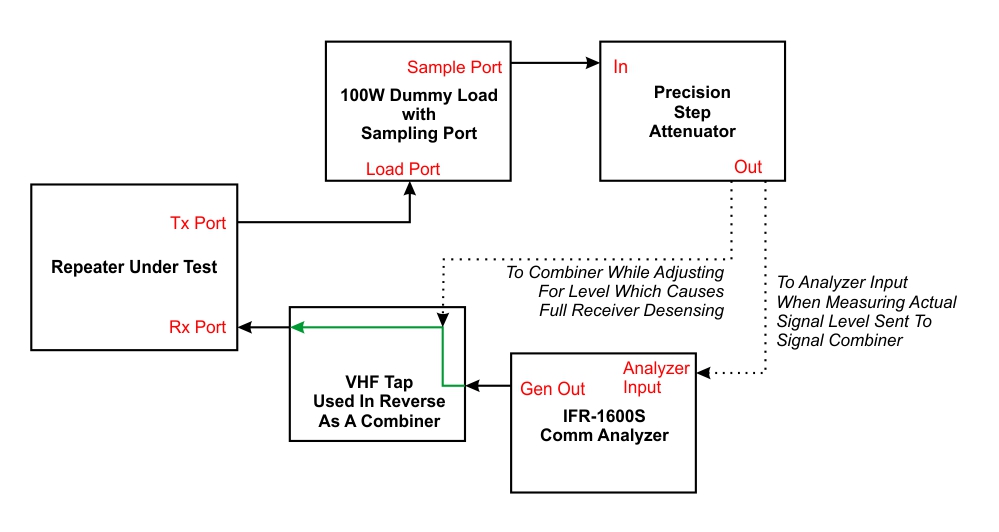
With the setup above, I sent a signal from the IFR-1600S to a combiner, the output of which was in turn routed to the receiver port of the repeater being tested. With the repeater activated, the transmitter output was sent to a 100 Watt dummy load with a reduced level sampling port. The output from that sampling port was then fed to a precision attenuator capable of 1-101 dB attenuation in 1 dB steps, the output of which was combined with the IFR’s output at the second input port of the combiner. This setup allowed me to combine a precisely adjustable amount of the transmitter’s output signal with the desired receive signal. By slowly decreasing the amount of attenuation of the transmit signal allowed into the combiner, I was able to determine how much RF power getting back into the repeater’s receiver would cause desensing. I kept adjusting until the level of the transmit signal going back into the combiner was high enough to cause total desensing of the receiver, meaning that the receiver was unable to discern enough receive signal to even do “cyclic” type key/unkey/key/unkey repeated desensing. The levels I created and measured resulted in total loss of useable reception in the receiver, effectively deafening and shutting down the repeater’s functionality altogether.
It is important to note that this testing does not address the levels at which “white noise” from the transmitter starts causing voice/modulation quality degradation in the repeater’s output. “White noise” and transmitted voice/modulation quality actually start occurring at much lower levels of unwanted transmit RF getting back into the receiver. Such noise gets progressively worse as the level of unwanted signal creeping back into the receiver increases, until it reaches the total desense level. Thus, the amounts of transmit/receive isolation needed (discussed a bit later in this article) in order to have clear, enjoyable QSO’s is actually considerably higher than the levels of rejection/isolation necessary just to avoid total desensing. Don’t use the isolation numbers shown in a bit to be the duplexer performance level you need for your repeater. Rather, the levels discussed in this article allow side-by-side comparison of the selectivity — or ability of each repeater’s receiver to block troublesome, unwanted signals and actually “pick out” and properly demodulate the desired signal.
For testing purposes, I used the following signals:
- Rx signal for the repeater: 147.660 MHz, modulated with a 1 KHz audible sine wave tone modulated at 3.0 KHz deviation, and a 123.0 Hz CTCSS tone modulated at a 0.6 KHz level for repeater PL tone operation. Signal level from IFR-1600S set to 0.224 uV for testing of both repeaters.
- Tx signal from repeater: 147.060 MHz with no tone generation being added by the repeater.
I chose these particular frequencies and tones for a simple reason: I had recently done a Mastr II repeater conversion for a local amateur radio club using that frequency pair and tones but it was still here in the lab, so a well functioning, properly aligned Mastr II set up as such was readily available. The Yaesu Fusion — being fully programmable and agile — was thus easy to set for identical frequencies and CTCSS operation.
Once I fired up each of the repeaters and had adjusted the level of the transmit signal being intentionally looped back into the receiver so that total desense occurred, I simply disconnected the feedback line from the combiner, which allowed the repeater to start repeating again. The level of the transmit signal coming from the test port of the dummy load and going into the precision attenuator had been measured just before conducting each desense level test. By calculating the resulting level after attenuation and factoring back in the amount of loss presented by the combiner, I was able to calculate the power level (calculated in uW (microwatts) in this instance) and record it. After putting both repeaters through this same test, I had the desired numbers at hand. I already knew that the differences between the Mastr II and Fusion would be noticeable, but they turned out to be a bit more so than I had suspected.
The Fusion repeater would totally desense with unwanted transmitter signal power of 4.77 uW. Contrast that to 80.8 uW that it took for the G.E Mastr II to reach total desense and a lot of things start becoming clearer. This table lists what I’ll refer to as the “Critical Rejection Level” — the amount of transmitter/receiver isolation necessary to prevent total desensing of the receiver for each
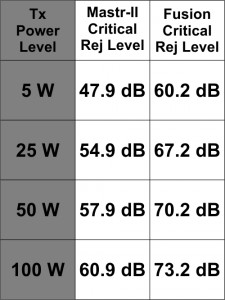
repeater. The table shows this estimated value calculated for operating each repeater at four power levels: 5, 25, 50, and 100 Watts. Please keep in mind, as mentioned before, that these are not intended to be absolute values to use for specifying duplexer parameters, etc. They are, however, numbers useful for comparison of the selectivity and desense avoidance capabilities of the Fusion and Mastr II. In my overall experience, the amount of transmitter/receiver isolation necessary to actually have relatively white noise-free, clear QSO’s in a repeater are generally 30-40 dB or so greater than what I refer to as the Critical Rejection Level. Shooting the middle and adding 35 dB to the numbers in this table yields numbers very comparable to the actual values of duplexer Tx/Rx isolation I’ve found necessary in real-world practice. I have found that the G.E. Mastr II VHF repeater will typically operate well in a relatively RF-clean environment with 80 dB or greater Tx/Rx isolation up to around 40 Watts, and do well up to 100-125 Watts with at least 100 dB of isolation. By contrast, the Yaesu Fusion is best operated with at least 80 dB of duplexer Tx/Rx isolation at 25 Watts or less, and definitely needs 100 dB or better in order to operate at its 50 Watt transmitter power level or with an outboard power amplifier running between 50 and 100 Watts (again, in a relatively CLEAN RF environment.) Also, these numbers relate only to transmitter/receiver isolation. Operating a repeater in a high-RF environment such as a commercial/broadcast transmitter site will create the need for specialized filtering (such as pre-filters), increased duplexer isolation rating needs, and frequently create intermodulation problems that call for lots of creativity and sometimes end up being impractical to try to overcome. I also have not done extensive testing to see whether or not the Fusion’s transmitter final/PA output is as good as the Mastr II in terms of any harmonics, spurious artifact, etc. in its “Fixed Analog FM” output mode. I suspect that it isn’t, but that’s research for yet another day. For now, suffice it to say that if it’s not, then things get even worse, but for the moment let’s at least imagine that the Fusion and the Mastr II have exactly the same output signal quality.
I am considering repeating these tests using the Fusion in UHF/70CM band and a Mastr II running at the same frequency/band. Almost all complaints I’ve heard regarding the Fusion having desense problems have been in the 2-Meter band, so that was my focus for today’s testing and documentation purposes.
I hope that this information sheds some light on why Fusion repeaters installed as replacements for Mastr II repeaters (and other commercial grade repeaters, such as Motorola equipment) so often create frustration and sleepless nights for so many repeater operators. My hat is off to the folks at Yaesu for creating some exciting, feature-rich repeaters in a price range that put them within the reach of many repeater owners who thought they’d never own a brand-spanking new repeater. Anyone considering purchasing a Fusion just needs to keep in mind that Fusion repeaters are ultimately ham/consumer level equipment and understand that they will not perform as well for analog communications as will a Mastr II or other commercial/professional grade repeater. Installing a Fusion using the same antenna, duplexers, connectors, and other hardware that was previously used with a properly working and aligned commercial grade repeater can and will quickly lead to great frustration unless you’re prepared to make a combination of changes and/or concessions.
73 Everyone!
Trimmer Capacitor Failures in Decibel Products Duplexers
This post could appropriately be subtitled “The Costs of Doing Good RF Business.” I’m a fan of Decibel Products duplexers because they do an excellent job in repeater applications. But like any piece of hardware, they are not immune to damage or failures. Many of Decibel Products’ duplexers (most notably the DB4060 and DB4062 VHF models) utilize precision trimmer capacitors which are the sort of component you love to hate.
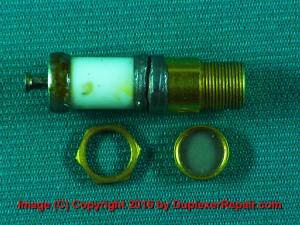
On the plus side, the capacitors (commonly referred to as “Johanson capacitors, after the company which manufactured the bulk of the caps used) are known for the ability to be very precisely tuned, largely due to the fact that it takes around 20 turns of the capacitor’s adjusting screw to go from one end of its capacitance range to the other. Compare this to many open plate type capacitors which go through their full capacitance range in only 1/2 turn and it’s obvious that very accurate and precise tuning is much easier using the Johanson type capacitor; however, utilizing them in a duplexer cavity also makes the cavity a bit more prone to fail under certain conditions. That’s the trade-off involved.
The very design elements which make the Johanson capacitors so great also make them much more fragile and more easily damaged. First of all, they are very small. The diameter of the outer ceramic cylinder of these capacitors is only 0.244” (6.20 mm to be more precise.) The component is hermetically sealed from the outside environment, which is good, because moisture and dust are enemies to such devices. At the same time, the very small enclosure size means that any heat in the device pretty much STAYS in the device until it dissipates through by conductive and convective methods — not always a fast process.
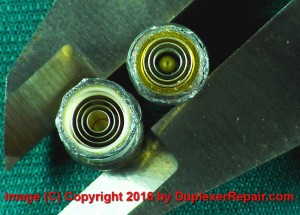
The actual capacitance creating part of these capacitors is a combination of concentric cylinders. One set of concentric cylinders is permanent attached to a stationary end inside the ceramic cylinder. A second set of cylinders is attached to the adjusting/tuning screw which has very, very fine pitched threads, giving the capacitor highly precise tuning ability because it takes so many turns to adjust it from one end of its range to the opposite end. As the screw is adjusted, this second set of metal cylinders moves in and out of the stationary set. If you’re familiar with electronics theory, you’ll recall that the two ways of varying the value of a capacitor (without altering the material used) is to either increase/decrease the size of the plates, or alter the spacing between the plates. A sort of combination of both variables has been accomplished in open-plate capacitors for ages by physically rotating one set of plates in and out of a second set in a horizontal fashion. This is the type of variable capacitor we see commonly used in everything from tiny transistor radios to the large open-plate variable capacitors used in high wattage antenna tuners/matchers. The difference in the Johanson capacitor’s operation is that they accomplish the same thing by changing how deeply the sets of concentric metal cylinders are meshed. They simply move in or out in a linear fashion.
The largest of the metal capacitor plate cylinders measures approximately 0.193″ (4.90 mm) outside diameter. Keep in mind that’s the LARGEST of the cylinders, which get increasing smaller in size, and there are seven total cylinders between the two sets. The smallest of the capacitive plate cylinders is approximately 0.063″ (1.60 mm) outside diameter. Metal objects this small can’t handle much heat, for starters. As those of us in the electronics and communications world all know, heat is not our friend. At the least, heat causes metals to expand. Given the miniscule size of these cylindrical capacitor plates, it wouldn’t take much heat to totally alter their size — thus the effective spacing between them — thereby changing the capacitance. These capacitors are used in the duplexer cavities to tune the rejection notch; therefore, if the capacitance changes, the notch tuning changes. If the notch tuning changes, the pass/reject performance of the cavity changes. In short, excessive heat buildup in the capacitor will cause the cavity and the duplexer set to fall below designed performance specifications. This obviously is not what we want happening.
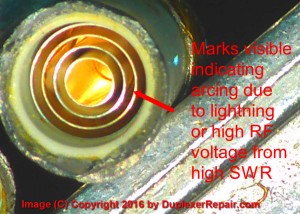
What would cause excessive heat buildup? A number of factors contribute to heat in the capacitors. First, RF energy by its very nature produces some amount of heat. That’s unavoidable. Many of the repeaters built or serviced by DuplexerRepair.com operate upwards of 100-125 Watts maximum. The higher the power from the repeater’s power amplifier, the more heat is generated in the cabling, duplexer cavities, and most importantly in the capacitors and other “loop” components. While RF energy that’s flowing through the devices is just part of the process, there are other causes which aren’t part of normal repeater operation which can be downright catastrophic, especially to these fragile capacitors we’re discussing.
High SWR in the antenna and feedline system can cause abnormal amounts of RF energy that’s supposed to be leaving the antenna in the form of electromagnetic waves to actually reflect back down the feedline to the duplexers. Since these capacitors are intended to help block the unwanted frequency from getting through by essentially creating a short-circuit to ground (the cavity cylinder itself is grounded) any increase in RF through the capacitor means increased heat. If the heat becomes great enough, the tiny capacitor cylinders themselves can expand to the point that they make physical contact between cylinders, essentially creating an RF short-circuit to ALL RF energy (meaning the frequency that’s supposed to be getting blocked along with everything else.) This short-circuit only leads to more and more heat, and it is commonly a cause of power amplifier/transmitter damage and failures as well. The end result is a catastrophic failure. If your antenna is mistuned or has problems leading to increased SWR, your duplexers are more likely to fail because of damage to these capacitors. Likewise, feedline problems such as physical damage (or even poor grade cabling/feedline) can cause high SWR and eventual failure. Lastly, mistuning of a cavity — even relatively slight — means needlessly increased RF energy is hitting places and components where you don’t want it to. Tick, tock… it’s just a matter of time until trouble occurs.
There’s also our other enemy in the radio world: lightning. Let’s face it, there’s not much need for technical explanation of the effects of lightning here, because we know it’s just downright destructive to communications equipment, and if it directly strikes an antenna (or even in close proximity) even the highest quality lightning protection devices can only do so much. If a hundred or so watts of misdirected energy can damage one of these capacitors, just imagine what a few megawatts from a lightning strike will do in terms of destructive effects. Enough said about that.
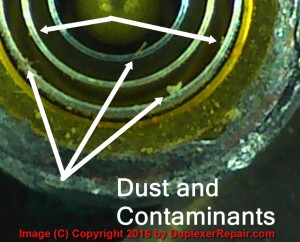
Dust particles and contaminants are theoretically kept out of these capacitors by sealing the plate cylinders inside the capacitor’s housing. The key word here is “theoretically.” Nothing is perfect. It only takes a few micron-sized particles of moisture or dust getting inside one of these capacitors to create a failure scenario. Moisture causes corrosion. Corrosion on the capacitive cylinders not only alters the capacitance but also creates potential conduction paths for electrical current which lead to RF short circuits. Dust particles similarly create unwanted conduction paths. Bottom line: we want to minimize any risk of contamination by moisture, dust, or other contaminant as much as
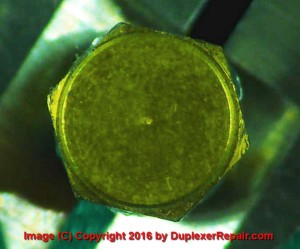
possible. They aren’t healthy for radio equipment, duplexer cavities, or these capacitors in particular. These capacitors come with protective screw-on sealing caps. They should be kept on the capacitors and fairly firmly tightened at all times, the only exception being while tuning is being performed on the duplexer assembly. Otherwise, moisture and micron sized particles of dust, etc. can and will eventually make their way between the tiny threads and into the capacitor, causing an eventual failure. Likewise, although it should not need to be pointed out: proper control of the ambient environment where the duplexers are installed is worth all the effort you put into it.
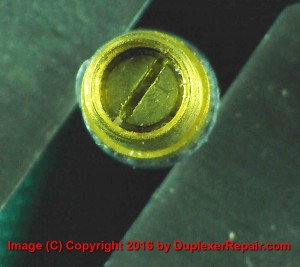
Something to watch for (or perhaps we should say “feel for”) if you’re tuning a set of duplexers which use these caps: very loose or tight feeling threads when turning the adjustment screw/slug. The screw should offer some/moderate resistance to being rotated for tuning; however, if it seems to spin pretty freely or feels as though it takes a lot of torque to turn it, the capacitor needs to be replaced. A loose turning adjustment screw usually means the capacitor is cracked (we’ve seen them broken completely into two halves, totally separated physically.) A tuning screw that feels excessively bound/tight typically means the capacitor has significant heat/lightning damage. In either case, you’ll only prolong the inevitable and end up “chasing your tail” trying to make the duplexers work properly and stay properly tuned and functioning. More often than not, Decibel Products duplexers we see in use by Amateur Radio folks are surplus/repurposed sets which had been used in commercial or public safety communications prior to being pulled out of service, eventually ending up in the hands of ham radio folks. We often suspect that the reason they were pulled from prior commercial/public safety use was due to… wait for it… failing capacitors which led to a two-way shop making the recommendation to just replace the whole set with new ones due to time constraints, and possibly because the radio shop can usually make more money selling a new set than they can by repairing the failed set. Plus, they often have to install another set immediately in order to get the system back in operation, so instead of the system being down twice it often makes more sense in those circles to just install new ones immediately. All that said, there’s probably a reason some ham got hold of the things for considerably less than the going price for new ones, and that reason is often undisclosed, unknown, and undetectable until attempts are made to actually put them to use in a repeater system. For those who have never done in-depth duplexer work, it’s worth mentioning that duplexers can often seem to work great when you’re testing and tuning them at power levels down in milliwatt/microvolt range but prove to be total garbage when you hit them with the sort of power levels coming out of a repeater’s transmitter. Experienced duplexer repair techs are better versed in things to look for which could spell trouble for duplexers in the real radio world.
There is another issue which can contribute to failure of these capacitors which should be pointed out: improper installation of the capacitors in the duplexer cavities. The capacitors most commonly used in the design of Decibel Products duplexers are attached to the cavity loop assembly by means of a stud/pin on the end of the capacitor which is soldered to the copper resonating loop. The opposing end is attached to the loop enclosure by means of a retaining nut. Because they are very easily damaged by heat, it’s extremely critical that the temperature and soldering time be precisely controlled. Not enough heat when soldering the capacitor in place will result in a poor solder connection (cold solder joint) which will have added resistance (heat buildup from RF current) or can open entirely, causing the cavity to fail. Too much heat during soldering will either destroy the capacitor immediately (and these things are not cheap) or do damage which will shorten the life of the capacitor tremendously. Proper installation of the retaining nut on the end of the capacitor which protrudes through the loop enclosure is also important. Too tight and the capacitor can be deformed and damaged. Too loose and the contact (conduction path) can be poor, plus the entire capacitor assembly may try to spin during adjusting, which can in turn break the capacitor assembly (if the solder joint at the other end is nice and strong) or torque the loop, resulting in deformation, pass frequency shifting, and a loop which might try to slowly move back into its proper shape (usually well after you’ve reinstalled the duplexers and left the repeater site) causing everything to go haywire — which Mr. Murphy delights in seeing happen at the most inopportune times. Decibel Products typically painted the loop enclosures AFTER installing the components including these capacitors. Some people complain about that making it more difficult to remove that tiny, ultra-fine threaded retaining nut. Don’t be a hater: by doing so they actually reduced the chances of the nut working loose and allowing things to move around which should be doing so. Kudos to Decibel for that decision. It’s not uncommon for the retaining nuts to bend, break, and generally become unrecognizable (not to mention unusable) when they have to be removed. That’s okay, because we only remove them to repair a loop enclosure (or modify it for operation at a different frequency range than it was originally manufactured for by fabricating replacement loops of the proper length for the desired frequency range.) If we break the nut, we’ll replace it, and it’s not uncommon for the entire capacitor to already be in need of replacement during the conversion. If we see signs of heat damage (such as discoloration on the ceramic enclosure) the capacitor will be replaced. At DuplexerRepair.com we are extremely careful and diligent when inspecting and installing these capacitors because we want you to get the longest possible life and best performance out of any equipment we repair or recondition. This in turn helps to minimize the risk of damage/failure of the other equipment in your communications system, such as your receivers, exciters, and power amplifiers.
By now you probably know more than you ever imagined you would (or wanted to) about the precision capacitors used in Decibel Products duplexer cavities. We just thought you deserved to be well informed of the pros, cons, and factors you should take into consideration regarding certain Decibel Products duplexers because of the capacitors used. We do highly recommend these duplexers because their design is excellent, their performance is fantastic, and the lifespan of Decibel Products duplexers between repairs/overhauls is wonderful, provided they — and the rest of your communications system — are installed and maintained properly. While we can’t control when and where lightning strikes will occur and cause damage to equipment, we can reduce the chances of system failures through proper attention to the details we do have some control over.
If you are the owner of a set of these Decibel Products duplexers and you need tuning, repair, conversion, or complete overhaul/refurbishing of a set, get in touch with us by calling (334) 787-9005 or by emailing service@duplexerrepair.com. We’ll have them in proper working order and back to you as quickly as possible (usually within 2-3 days, although sometimes it takes a bit longer, especially if parts/cables have to be fabricated or special-ordered.)